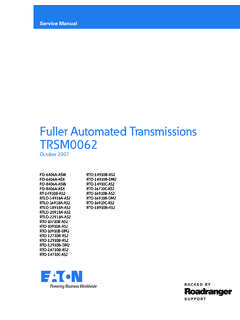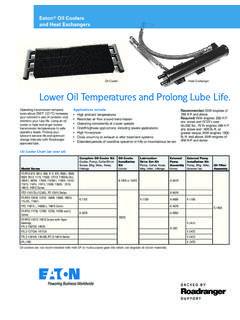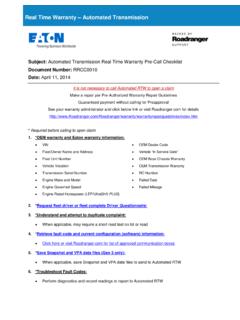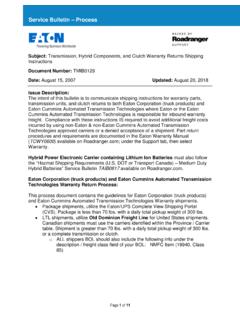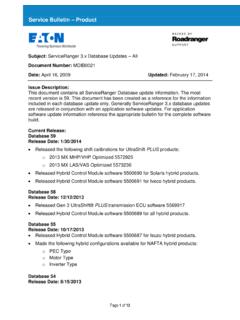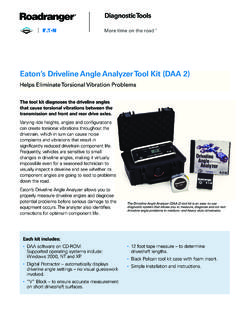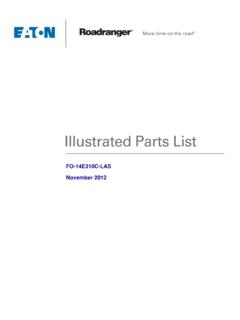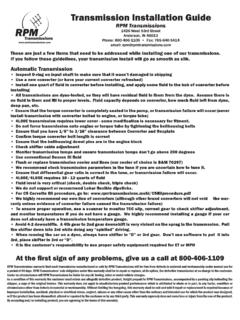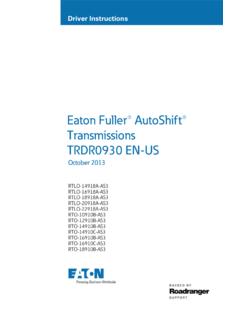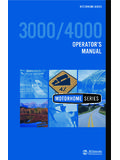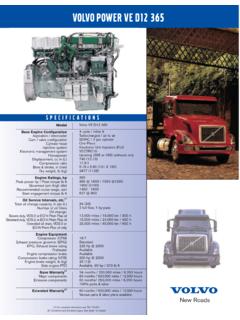Transcription of Proper Shifting of Synchronized Manual Transmissions Œ …
1 Driver InstructionsProper Shifting of Synchronized Manual TransmissionsTRDR0074 September 2010 This page intentionally left Shifting of Synchronized Manual Transmissions Rev. 1 Introduction Currently, most Manual Transmissions are Synchronized , which means gear shifts can be completed quickly and with low shift-knob force for most operating conditions. Synchronizers make this possible because they equalize the speeds of rotating gears and shafts inside Transmissions before gear shifts are completed. They are designed to survive several hundred thousands of kilometers; unfortunately, synchronizers could wear prematurely or even be destroyed by improper driver actions. This paper helps truck owners and drivers to properly shift Synchronized Transmissions .
2 Synchronizer Performance & Durability There are several factors that influence synchronizer performance and durability time and force for a shift, number of shifts, operating conditions (for example; temperature and lubrication), and friction material. The time and force for a Synchronized shift depends on how quickly a driver shifts from one gear to another and the shift-knob force used to complete the shift. Good performance usually means a smaller shift-knob force and a shorter time to complete a shift; both are highly dependent on the design of the synchronizer and shift linkage, so the major concern of this paper is durability because the design is fixed. Durability is the number of completed shifts, which depends on the friction-material s wear rate, and the wear rate primarily depends on the force exerted by the driver or shift mechanisms, such as a pneumatic power assist (PPA).
3 But, there are several major factors, in addition to shift-knob force, that influence durability, and they can be summarized as those outside the control of the driver and those directly dependent on driver actions: 1. Outside the Control of Drivers a. Transmission Design b. Master Clutch c. Vehicle Configuration d. Type of Lubrication e. Operating Conditions f. Friction Material 2. Dependent on Driver Actions. a. Shifting Habits b. Accidentally Making the Wrong Shift c. Driving Style d. Clutch Operation e. PTO Operation f. Proper Service This paper addresses the durability factors that are dependent on driver actions. Shifting Habits This refers mainly to the Shifting sequence the driver usually follows.
4 The recommended sequence is to shift gears sequentially; that is, shift from one gear to the next without skipping any gear positions for examples, 1-2, 2-3 .. or 3-2, 2-1 and so forth. Sometimes drivers skip gear positions called skip Shifting such as 1-3, 4-6, 4-2, or 3-1. Skip Shifting is not prohibited, but one should know that it significantly increases the speed and force on the synchronizers, which means a higher wear rate. A skip shift is often times the equivalent of several sequential shifts. Skip Shifting often requires more shift-knob force to make the shift and often takes longer to complete the shift. To achieve the longest possible synchronizer life, drivers should avoid skip Shifting as often as possible.
5 Shifting Habits Some drivers shift gears steadily, rhythmically and calmly, while some shift more aggressively. Shifting habits involve the engine speed at which a gear shift is made and the force a driver applies to the shift-knob. Higher speeds and forces create higher synchronizer load; therefore, to extend synchronizer life, shift at lower engine speeds with a minimum force to the shift-knob. While accelerating a fully loaded truck it is useful to have full engine torque available just after a shift. To do this, make an up-shift when the engine speed is slightly above the speed at which maximum torque can be produced by the engine, even if you have to increase the engine speed just as you are beginning a shift.
6 The minimum engine speed for maximum torque is different for each engine, but it usually lies between 1100 and 1400 rpm (check your engine characteristics). For example, the maximum torque for one engine is nearly constant at engine speeds between 1200 and 1800 rpm, with a maximum engine speed of 2500 rpm, Do not rest a hand on the shift-knob while driving. Doing so imparts a force to the Shifting mechanism that can push shift forks and synchronizers into contact with other parts rotating at different speeds, which can lead to premature wear out. Do not down-shift at high road speeds. Do not make double skip down-shifts because they can destroy a synchronizer in one shift. which means, an up-shift should begin at just over 1200 rpm.
7 Using the engine in the example and a six speed transmission in a specific vehicle configuration (axle ratio, tire size) it would be enough to run the engine up to 2100 rpm for the first 3 gears, up to 1900 rpm for 4th gear and about 1700 rpm for 5th and 6th gear. Picture 1 shows the difference in the synchronizer load for two shifts one shift starts at 2500 rpm and the other shift starts at 2100 rpm for a 6 speed transmission. Notice that the shift energy is approx 42% lower when Shifting at a lower engine speed. Less dissipated energy means less heat generated and less wear; therefore, longer life. Synchronization Energy Comparison01002003004005006007006-55-44- 33-22-11-22-33-44-55-6 ShiftEnergy [J]speed 2500 RPMspeed 2100 RPM Picture 1.
8 Synchronizer energy difference during gear changing at various engine speed The shift-knob force applied by the driver to make a gear shift influences the time to make the shift and the synchronizer load. A higher shift-knob force shortens synchronization time (gear shift), but creates higher power at the synchronizer. You will also find for up-shifts (ex. 1-2, 2-3 and so forth) that it is beneficial to wait in neutral for relatively small period of time ( to 1 second) before engaging the target gear to allow time for the rotating masses inside the transmission to decelerate. During this short delay in neutral (clutch disengaged), oil drag on rotating components inside the transmission will help decrease speed difference so that the up-shift will be easier.
9 During down-shifts (ex. 3-2, 2-1), it is beneficial to cross neutral very quickly to begin accelerating rotating masses inside the transmission as soon as possible; oil will slow down the targeted rotating masses which makes a down-shift harder because the speed difference. Clutch operation Some Transmissions may not have synchronizers for reverse (R) or crawler (C) gears. To avoid grinding during shifts to reverse (R) or crawler (C), make sure the vehicle is not moving, make sure the engine is at idle speed prior engaging reverse or crawler, and allow some time (few seconds) in neutral with the clutch disengaged for an easy and quiet shift. PTO operation PTO Power Take Offs driven by a transmission are commonly used in many applications (fire trucks, tippers etc).
10 Usually the PTO is driven by a lay-shaft within the transmission. Proper service Use the recommended oil, change it at the recommended interval and fill the transmission with oil to the Proper level. The main function for transmission oil for synchronizers is cooling. Also, keep the oil clean because contamination may damage the friction material and premature wear will occur. In 9-speed Transmissions FS(O)xx09, FS(O)10309, and ES(O)xxx09 with an epicyclical reduction gear synchronizer, a pneumatic system makes each shift. It is important to keep the air pressure supply at the specified value and the filter/regulator (mounted on a transmission) working correctly (refer to Eaton service manuals).


